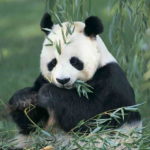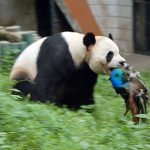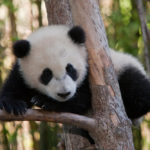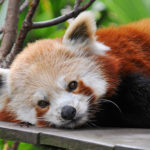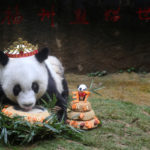Pandas
 There are 2 kinds of pandas – a well-known to all the big panda and its less famous cousin the small one. These animals are not very similar to one another and their systematic position raises many questions. The average panda is considered a bear by a bear, while scientists rank it among raccoons for a number of reasons. The controversy over whether a large panda is a giant raccoon or a bear has not abated until now. Officially, this beast consists of a special subfamily of the bear. But the small panda is more like a marten and it is isolated in a separate family of small pandas.
There are 2 kinds of pandas – a well-known to all the big panda and its less famous cousin the small one. These animals are not very similar to one another and their systematic position raises many questions. The average panda is considered a bear by a bear, while scientists rank it among raccoons for a number of reasons. The controversy over whether a large panda is a giant raccoon or a bear has not abated until now. Officially, this beast consists of a special subfamily of the bear. But the small panda is more like a marten and it is isolated in a separate family of small pandas.
The shape of a large panda is well known. This is a large animal weighing up to 160 kg, a typically bearish physique. The big panda has a bright contrasting color: the head, shoulders and belly are white, the paws, ears and “glasses” around the eyes are black. Paws of the big panda have a peculiar structure: 6 fingers on them, 5 of which are real, and the sixth is a modified bone, protruding to the side. This almost human palm structure helps pandas to hold the stems of bamboo.
Pandas live in a very limited area – they can only be found in southern China, in Sichuan. These animals are inhabited by mountain forests with bamboo thickets. Pandas lead a solitary life. Most of the time they slowly move around in search of food and chew on it methodically.
Unlike other bears, they do not fall into a hibernation. The nature of these animals is very calm, even phlegmatic, but with joint keeping in zoos, pandas, especially young ones, like to play.
A distinctive feature of pandas is that they are almost full vegetarians and with a very selective diet. The basis of their food is bamboo: pandas eat all of it, preferring branches. In connection with such a diet, the stomach has a very thick mucous membrane, protecting it from sharp bamboo chips. Because of the low caloric content of the food consumed, pandas are forced to eat a large amount: panda can eat up to 30 kg per day, which is 20-40% of the animal’s weight! Sometimes pandas eat other plants, as well as small animals, eggs, fish and carrion. About these predatory instincts are often forgotten by visitors to zoos, deceived by the toy kind of pandas. But the panda can show aggression to importunate visitors!
Fertility in these animals is very low, they are not characterized by violent mating games. The mating season comes in the spring, the pregnancy lasts 150-160 days. The female gives birth to a very small calf (extremely rarely two). Compared with the size of the mother, the newborn is just a crumb.
The female carefully protects the cub, and the baby is growing rapidly. Little pandas are very mobile and curious. They are prone to adventures and are always looking for some kind of entertainment. When kept together in zoos, the pandas are friendly to their fellows.
In natural conditions, pandas do not have enemies, but these animals are very vulnerable to natural disasters. The main danger for them is the mass flowering of bamboo. This durable plant blooms only once in a lifetime, after which it dies. With mass flowering and the subsequent death of bamboo in large areas, pandas lose food for good. They can be saved only by migration to more feeding places. But in modern China there are not so many natural habitats, because of which the migration of animals becomes impossible. Panda saves only that they have acquired in the eyes of people the image of a popular, even cult beast. Therefore, the Chinese government invests heavily in the program for the protection and breeding of pandas.










